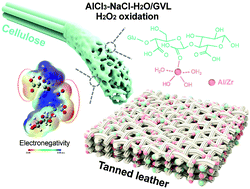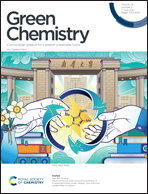Advanced masking agent for leather tanning from stepwise degradation and oxidation of cellulose†
Abstract
An oligosaccharide-based masking agent suitable for chrome-free metal tanning was produced from cellulose via a stepwise degradation and oxidation process. Firstly, an AlCl3-NaCl-H2O/γ-valerolactone (GVL) biphasic solvent system was established for cellulose conversion (87.6%), which allowed in situ separation of the oligosaccharides and valuable small molecules into the two phases. Then, a H2O2 oxidation process enabled further degradation of the oligosaccharides and introduced –CHO/–COOH groups. This process strengthened the surface charge of the oligosaccharides, enhancing their coordination ability with metal ions. The post-oxidized fraction, together with added Zr species, exhibited satisfactory tanning performance, with a shrinkage temperature of 85.2 °C for the tanned leather. Al/Zr species could spontaneously coordinate with O atoms of O![[double bond, length as m-dash]](https://www.rsc.org/images/entities/char_e001.gif) C(2) in the carboxylic group of post-oxidized oligosaccharides, which promoted the penetration of Al/Zr species into the leather matrix for efficient crosslinking reactions.
C(2) in the carboxylic group of post-oxidized oligosaccharides, which promoted the penetration of Al/Zr species into the leather matrix for efficient crosslinking reactions.



 Please wait while we load your content...
Please wait while we load your content...